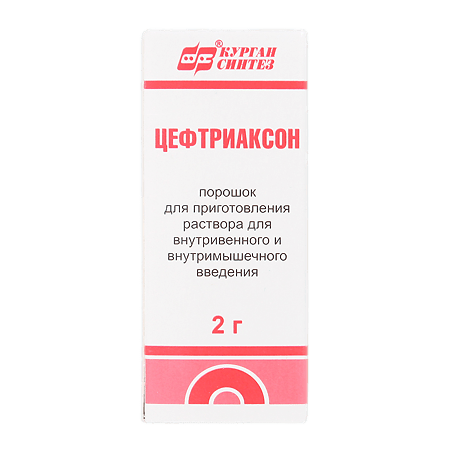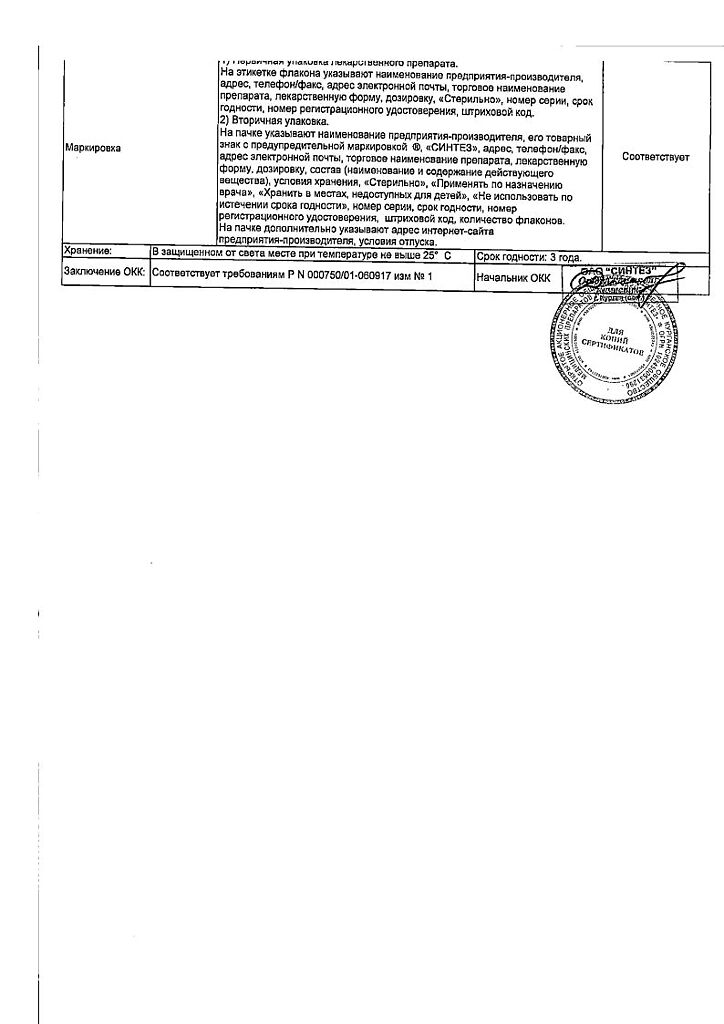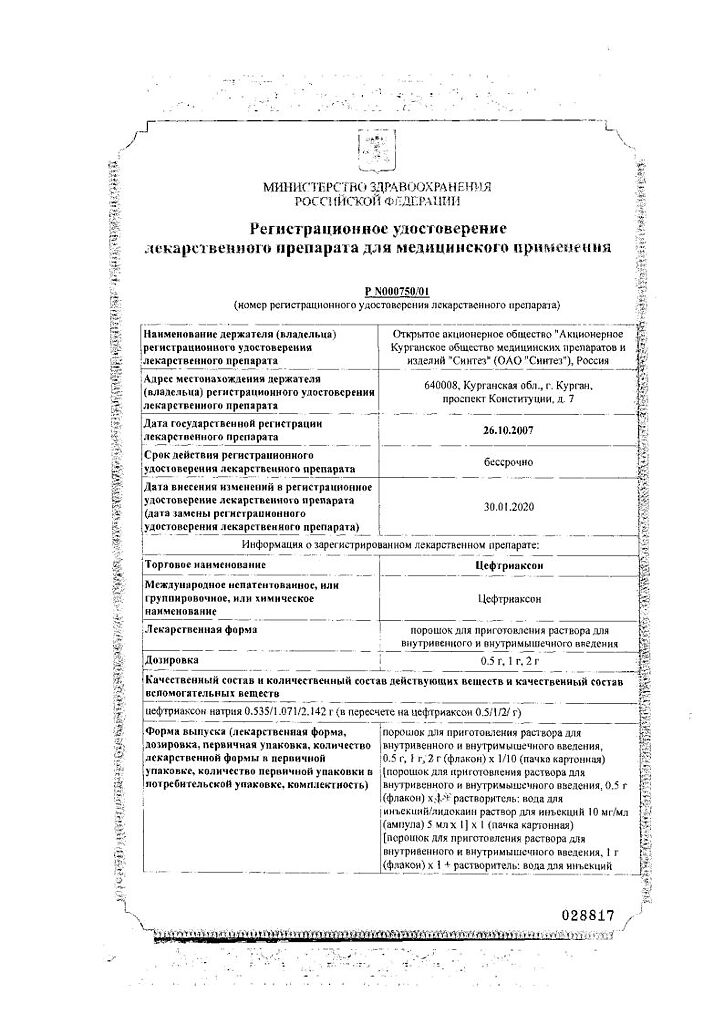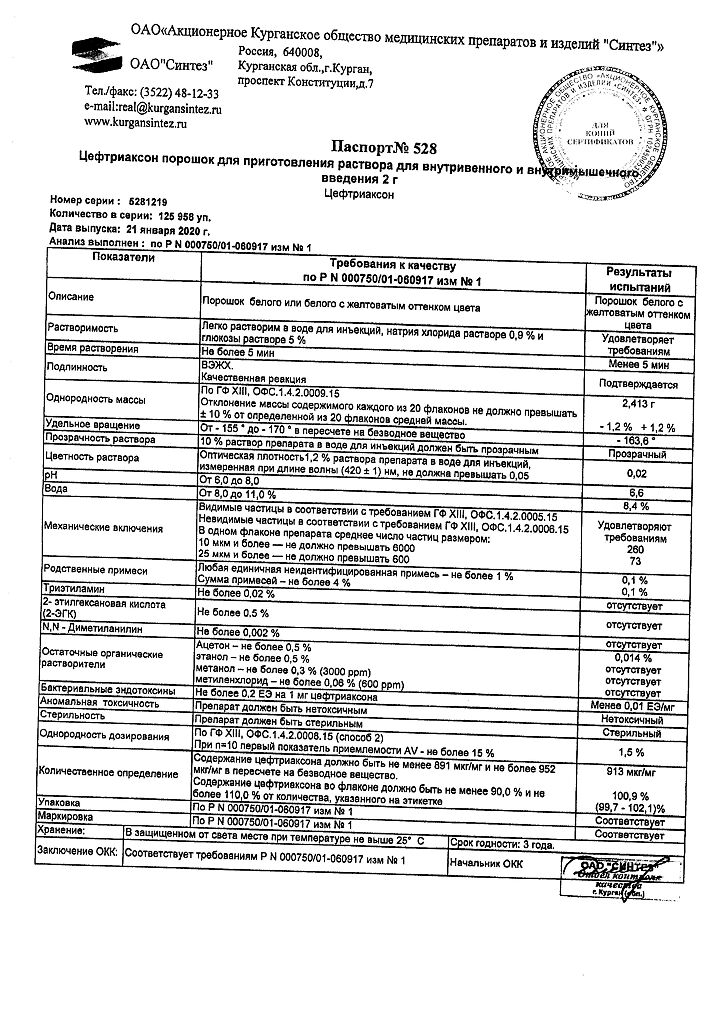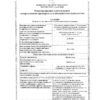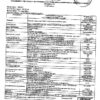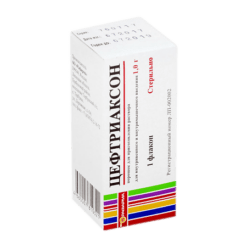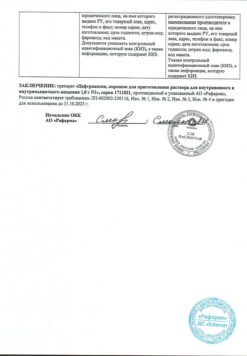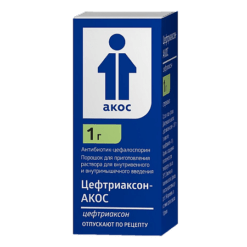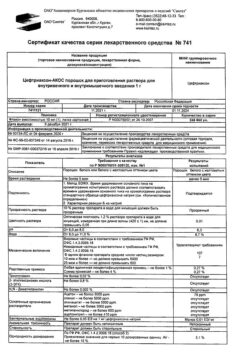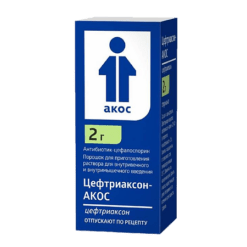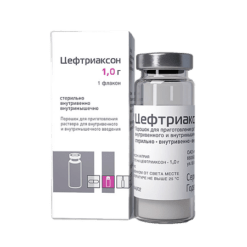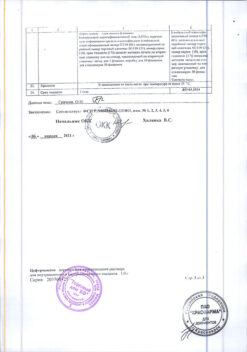No products in the cart.
Ceftriaxone-ACOS, 2 g 50 pcs
€1.00
Out of stock
(E-mail when Stock is available)
Description
Ceftriaxone is a third-generation broad-spectrum cephalosporin antibiotic. It acts bactericidally by inhibiting the synthesis of the cell wall of microorganisms. It is resistant against β-lactamases of most gram-positive and gram-negative bacteria.
Active against Gram-positive aerobic bacteria: Staphylococcus aureus (including penicillinase-producing strains), Staphylococcus epidermidis, Streptococcus pneumoniae, Streptococcus pyogenes, Streptococcus viridans; Gram-negative aerobic bacteria: Acinetobacter calcoaceticus, Enterobacter aerogenes, Enterobacter cloacae, Escherichia coli, Haemophilus influenzae (including penicillinase-producing strains), Haemophilus parainfluenzae, Klebsiella spp. (including Klebsiella pneumoniae), Moraxella catarrhalis (including penicillinase-producing strains), Morganella morganii, Neisseria gonorrhoeae (including penicillinase-producing strains), Neisseria meningitidis, Proteus mirabilis, Proteus vulgaris, Serratia spp. (including Serratia marcescens), Pseudomonas aeruginosa (separate strains); anaerobic bacteria: Bacteroides fragilis, Clostridium spp. (except Clostridium difficile), Peptostreptococcus spp.
It has in vitro activity against most strains of the following microorganisms, although the clinical significance of this is unknown: Citrobacter diversus, Citrobacter freundii, Providencia spp. (including Providencia rettgeri), Salmonella spp. (including Salmonella typhi), Shigella spp, Streptococcus agalactiae, Bacteroides bivius, Bacteroides melaninogenicus.
Methicillin-resistant staphylococci are also resistant to cephalosporins, including ceftriaxone. Many strains of group D streptococci and enterococci (including Enterococcus faecalis) are also resistant to ceftriaxone.
Pharmacokinetics
Absorption and distribution
After intramuscular administration ceftriaxone is quickly and completely absorbed into the systemic bloodstream. It penetrates well into the tissues and fluid media of the body: respiratory tract, bones, joints, urinary tract, skin, subcutaneous tissue and abdominal organs. In case of meningeal inflammation, it penetrates well into the cerebrospinal fluid. Bioavailability of ceftriaxone during intramuscular administration is 100%. After intramuscular administration Cmax is reached after 2-3 hours, when administered intravenously – at the end of the infusion.
In intramuscular administration of ceftriaxone at a dose of 500 mg and 1 g, the Cmax in plasma is 38 µg/ml and 76 µg/ml, respectively, when administered intravenously at doses of 500 mg, 1 g and 2 g, 82 µg/ml, 151 µg/ml and 257 µg/ml, respectively. In adults, 2-24 hours after administration of the drug at a dose of 50 mg/kg, the concentration in the cerebrospinal fluid is many times higher than the MPC for the most common causative agents of meningitis.
Reversible binding to plasma proteins (albumin) is 83-95 %.
Vd is 5.78-13.5 l (0.12-0.14 l/kg), in children 0.3 l/kg. T1/2 is 6-9 hours. Plasma clearance is 0.58-1.45 l/hour, renal clearance – 0.32-0.73 l/hour.
In adults 50-60% of preparation is excreted unchanged by kidneys in 48 hours, 40-50% is excreted with bile in intestine, where it is transformed into inactive metabolite.
Pharmacokinetics in special clinical cases
In newborn children the kidneys excrete about 70% of the drug.
In newborns and elderly persons (over 75 years of age), as well as in patients with renal and hepatic dysfunction, the T1/2 is significantly prolonged.
In patients on hemodialysis at a CK of 0-5 ml/minute, the T1/2 is 14.7 hours; at a CK of 5-15 ml/minute, 15.7 hours; at a CK of 16-30 ml/minute, 11.4 hours; at a CK of 31-60 ml/minute, 12.4 hours.
In children with meningitis, the T1/2 after intravenous administration at a dose of 50-75 mg/kg is 4.3-4.6 hours.
Indications
Indications
Bacterial infections caused by sensitive microorganisms: infections of the abdominal organs (peritonitis, inflammatory diseases of the gastrointestinal tract, biliary tract, including cholangitis, empyema of the gallbladder), infections of the pelvic organs, infections of the lower respiratory tract (including pneumonia, lung abscess, pleural empyema), acute otitis media, infections of bones and joints, skin and soft tissues (including infected wounds and burns), urinary tract infections (complicated and uncomplicated), uncomplicated gonorrhea, bacterial meningitis, bacterial septicemia, Lyme disease.
Prevention of postoperative infections.
Infectious diseases in people with weakened immune systems.
Pharmacological effect
Pharmacological effect
Ceftriaxone is a third generation cephalosporin antibiotic with a broad spectrum of action. It has a bactericidal effect, inhibiting the synthesis of the cell wall of microorganisms. Resistant to β-lactamases of most gram-positive and gram-negative bacteria.
Active against gram-positive aerobic bacteria: Staphylococcus aureus (including strains producing penicillinase), Staphylococcus epidermidis, Streptococcus pneumoniae, Streptococcus pyogenes, Streptococcus viridans; gram-negative aerobic bacteria: Acinetobacter calcoaceticus, Enterobacter aerogenes, Enterobacter cloacae, Escherichia coli, Haemophilus influenzae (including penicillinase-producing strains), Haemophilus parainfluenzae, Klebsiella spp. (including Klebsiella pneumoniae), Moraxella catarrhalis (including penicillinase-producing strains), Morganella morganii, Neisseria gonorrhoeae (including penicillinase-producing strains), Neisseria meningitidis, Proteus mirabilis, Proteus vulgaris, Serratia spp. (including Serratia marcescens), Pseudomonas aeruginosa (certain strains); anaerobic bacteria: Bacteroides fragilis, Clostridium spp. (except Clostridium difficile), Peptostreptococcus spp.
Has in vitro activity against most strains of the following microorganisms, although the clinical significance is unknown: Citrobacter diversus, Citrobacter freundii, Providencia spp. (including Providencia rettgeri), Salmonella spp. (including Salmonella typhi), Shigella spp., Streptococcus agalactiae, Bacteroides bivius, Bacteroides melaninogenicus.
Methicillin-resistant staphylococci are also resistant to cephalosporins, including ceftriaxone. Many strains of group D streptococci and enterococci (including Enterococcus faecalis) are also resistant to ceftriaxone.
Pharmacokinetics
Suction and distribution
After intramuscular administration, ceftriaxone is quickly and completely absorbed into the systemic circulation. Penetrates well into tissues and fluids of the body: respiratory tract, bones, joints, urinary tract, skin, subcutaneous tissue and abdominal organs. In case of inflammation of the meningeal membranes, it penetrates well into the cerebrospinal fluid. The bioavailability of ceftriaxone when administered intramuscularly is 100%. After intramuscular administration, Cmax is achieved after 2-3 hours, with intravenous administration – at the end of the infusion.
With intramuscular administration of ceftriaxone at a dose of 500 mg and 1 g, Cmax in blood plasma is 38 mcg/ml and 76 mcg/ml, respectively, with intramuscular administration at a dose of 500 mg, 1 g and 2 g – 82 mcg/ml, 151 mcg/ml and 257 mcg/ml, respectively. In adults, 2-24 hours after administration of the drug at a dose of 50 mg/kg, the concentration in the cerebrospinal fluid is many times higher than the MIC for the most common pathogens of meningitis.
The equilibrium state is established within 4 days of drug administration.
Reversible binding to plasma proteins (albumin) is 83–95%.
Vd is 5.78-13.5 l (0.12-0.14 l/kg), in children – 0.3 l/kg.
Removal
T1/2 is 6-9 hours. Plasma clearance – 0.58-1.45 l/hour, renal clearance – 0.32-0.73 l/hour.
In adult patients, within 48 hours, 50-60% of the drug is excreted unchanged by the kidneys, 40-50% is excreted with bile into the intestines, where it is biotransformed into an inactive metabolite.
Pharmacokinetics in special clinical situations
In newborns, about 70% of the drug is excreted by the kidneys.
In newborns and the elderly (over the age of 75 years), as well as in patients with impaired renal and liver function, T1/2 increases significantly.
In patients on hemodialysis with CC 0-5 ml/min, T1/2 is 14.7 hours; with CC 5-15 ml/minute – 15.7 hours; with CC 16-30 ml/minute – 11.4 hours; with CC 31-60 ml/minute – 12.4 hours.
In children with meningitis T1/2 after intravenous administration at a dose of 50-75 mg/kg is 4.3-4.6 hours.
Special instructions
Special instructions
When using the drug, the risk of developing anaphylactic shock and the need for appropriate emergency treatment should be taken into account.
In vitro studies have shown that ceftriaxone (like other cephalosporins) is able to displace bilirubin bound to serum albumin. Therefore, in newborns with hyperbilirubinemia and especially in premature newborns, the use of ceftriaxone requires even greater caution.
When severe renal failure and severe liver failure are combined in patients on hemodialysis, the plasma concentration of the drug should be regularly determined.
With long-term treatment, it is necessary to regularly monitor the peripheral blood picture, indicators of the functional state of the liver and kidneys.
In rare cases, ultrasound of the gallbladder reveals darkening, which disappears after cessation of treatment. Even if this phenomenon is accompanied by pain in the right hypochondrium, continued therapy with Ceftriaxone and symptomatic treatment are recommended.
Elderly and debilitated patients may require vitamin K.
During treatment, alcohol consumption is contraindicated, because disulfiram-like effects are possible (facial hyperemia, spasms in the abdomen and stomach area, nausea, vomiting, headache, decreased blood pressure, tachycardia, shortness of breath).
Active ingredient
Active ingredient
Ceftriaxone
Composition
Composition
1 bottle of powder for preparing a solution for intravenous and intramuscular administration contains:
active substance:
ceftriaxone (in the form of disodium salt) 2 g.
Pregnancy
Pregnancy
The use of the drug during pregnancy is possible only if the expected benefit to the mother outweighs the potential risk to the fetus.
If it is necessary to use the drug during lactation, breastfeeding should be stopped.
Contraindications
Contraindications
Hypersensitivity (including to other cephalosporins, penicillins, carbapenems), hyperbilirubinemia in newborns, newborns who are indicated for intravenous administration of solutions containing Ca2+.
With caution. Premature babies, renal and/or liver failure, ulcerative colitis, enteritis or colitis associated with the use of antibacterial drugs, pregnancy, lactation
Side Effects
Side Effects
From the central nervous system: headache, dizziness.
From the urinary system: oliguria, impaired renal function, glucosuria, hematuria, hypercreatininemia, increased urea content.
From the digestive system: nausea, vomiting, taste disturbance, flatulence, stomatitis, glossitis, diarrhea, pseudomembranous enterocolitis, pseudocholelithiasis (sludge syndrome), dysbacteriosis, abdominal pain, increased activity of liver transaminases and alkaline phosphatase, hyperbilirubinemia.
From the hematopoietic system: anemia, leukopenia, leukocytosis, lymphopenia, neutropenia, granulocytopenia, thrombocytopenia, thrombocytosis, basophilia, hemolytic anemia.
From the blood coagulation system: nosebleeds, increase (decrease) in prothrombin time.
Allergic reactions: urticaria, rash, itching, exudative erythema multiforme, fever, chills, edema, eosinophilia, anaphylactic shock, serum sickness, bronchospasm.
Other: superinfection (including candidiasis).
Local reactions: with intravenous administration – phlebitis, pain along the vein; with intramuscular injection – pain at the injection site.
Interaction
Interaction
Ceftriaxone and aminoglycosides are synergistic against many gram-negative bacteria.
Possible simultaneous administration with metronidazole, fluoroquinolones, vancomycin, rifampicin (but not in the same syringe).
When used simultaneously with loop diuretics (for example, furosemide), renal dysfunction is not observed.
Pharmaceutical interactions
Pharmaceutically incompatible with solutions containing other antibiotics.
Overdose
Overdose
Hemodialysis is ineffective for removing the drug from the body.
In the presence of clinical manifestations of overdose, symptomatic therapy is recommended.
Storage conditions
Storage conditions
In a dry place, protected from light, at a temperature not exceeding 25 °C
Shelf life
Shelf life
2 years
Manufacturer
Manufacturer
Sintez, Russia
Additional information
| Shelf life | 2 years |
|---|---|
| Conditions of storage | In a dry, light-protected place at a temperature not exceeding 25 °C |
| Manufacturer | Sintez OAO, Russia |
| Medication form | Powder for preparation of solution |
| Brand | Sintez OAO |
Other forms…
Related products
Buy Ceftriaxone-ACOS, 2 g 50 pcs with delivery to USA, UK, Europe and over 120 other countries.

